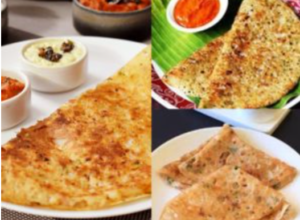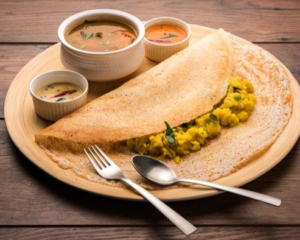DIFFERENCE BETWEEN RAVA DOSA & MASALA DOSA
I bet you didn’t know these facts about dosas. Dosa is one of the most famous South Indian dishes listed in the world’s 50 most delicious food.
India has a varied food culture. You will find a variety of food as you travel to the different regions of the country. If you observe India in the North and South regions, you will find a vast difference in the taste of food. As Paratha is the heart of North India, Dosa is the heart of South India. North Indian dishes are spicy and delicious in their own way, whereas South Indian dishes are less spicy, less oily comparatively, and easygoing too as South Indian recipes are less time-consuming.
If we go into detail about South Indian Breakfast, the dishes included are dosa, idli, puddle, and varieties of rice. One of the most famous South Indian dishes is Dosa.
Dosa is a rice pancake made out of the fermented batter. There are different varieties of dosas as per the taste and rice is the major portion of south Indian food. Different types of dosas are made depending on the regions you go to. The most difference between rava dosa and masala dosa is eye-catching.
This blog focuses on the difference between Rava Dosa and Masala Dosa and how both dosas are everyone’s favorite.
Rava Dosa
If you are not someone who plans their breakfast or lunch menu the day ahead, then this recipe is for you. This dosa can be made instantly and it does not require any kind of batter fermentation. The major difference between rava dosa and masala dosa is the process of fermentation. Rava dosa is also the easiest to make.
Rava dosa is a semolina or suji dosa This dosa tastes very different from the regular plain dosa, as the ingredients used are completely different.

Ingredients:
- ½ cup rava(suji or semolina)
- ½ cup rice flour
- ¼ cup all-purpose flour
- 1 tablespoon curd
- 2-3 tablespoon oil
- 3-4 tablespoons finely chopped onion
- 1 green chilly(grated)
- 1 tablespoon ginger(grated)
- ½ tablespoon cumin seeds
- 2 to 2 ½ cup water
- 2 tablespoons finely chopped coriander leaves.
- Salt as per taste.
Important Notes:
- The complete recipe of rava dosa depends on the consistency of the batter we make. Unlike plain dosa, the batter of rava dosa has to be kept thin. If the batter is too thick it might stick on the pan and make it difficult to flip later and also the dosa becomes too fat. Make sure the batter is in liquid runny form (thin enough) but do not make it too thin.
- And also the rava dosa has to be cooked on both sides till we get the light brown crispy side.
- Do not spread the batter in a circular motion as we generally do while making plain dosa, but pour the batter in a circular way.
- If you are a beginner, you need to practice it a bit to make them perfect.
Directions:
- Add all the above-mentioned ingredients to a bowl and keep them at rest for 30 minutes. Once the batter is kept for this long time, rava will absorb all water. You will have to add more water to keep the proper consistency of the batter.
- Heat a dosa pan and grease it with a wet cloth. Make sure you follow this step before making each dosa.
- Take a batter full ladder and pour the batter and rotate it in a circular motion. Kindly make a note that the rava dosa has more pores and is not as smooth as we get in the plain dosa. You might have to stir the batter well and add the batter later in the gaps in between.
- Now add oil around the round crepe and also above the crepe.
- Once it is done cooking, it will begin to peel off the edges on its own. Now flip the dosa and cook on the other side too till it becomes crispy golden brown colour.
- You can add red chutney if you wish to make spicy dosa.
Rava dosa is a very healthy nutritious breakfast and super tasty. Enjoy them along with chutney and sambar.
Just to add some spice to the world of dosas, check out the below recipe of Masala Dosa.
Masala Dosa
Masala Dosa is famous for its spice and the art of making it. When you make a plain dosa and add stuffing(mainly potato curry) it is considered as masala dosa. You can make it as spicy as per your taste buds and keep it to normal taste if required too. Most spice lovers make this dosa, but if you plan this recipe in the morning then you can just lower the amount of red chutney and control the spice levels. This dosa is consumed along with chutney and sambar.
In India, you can find around 100 varieties of dosa, mostly made from the same batter as plain dosa. But let’s discuss our favorite variety first. If we classify the dosa in the texture, then can be classified as soft dosa, crispy dosa, or fat flat dosa.

Plain Dosa is a thin crepe made of a fermented batter of rice and urad(black lentil) dal and hence requires a little planning ahead of the day.
Below mentioned ingredients make for the perfect delicious masala dosa.
Ingredients:
Plain Dosa
- ½ cup urad dal( black gram or black lentil)
- 1 ½ cup rice( you can use the normal rice or parboiled rice)
- ¼ or 1/3 teaspoon methi seeds( fenugreek seeds)
- Salt( regular or rock salt)
Potato curry masala:
- 400 grams potato( boil,peel and cut into square cubes)
- 1 medium piece onion(chopped)
- ½ tablespoon ginger chopped( 1 inch)
- 2 tablespoon oil
- ½ tsp mustard
- ½ tsp cumin
- 1 tsp turmeric
- 1 pinch hing
- 1 tsp chana dal
- 1 tsp urad dal
- 5-6 leaves of curry leaves
- 1-2 green chilies (chopped)
- Salt as per taste
- 2 tbsp coriander(chopped for garnishing)
Directions:
Dosa batter
- Note a few things before making a dosa batter.
- Wash urad dal, rice, methi(fenugreek seeds) in a different bowl and soak them in water for 4 hours. Later remove the soaked water and grind them separately in the wet grinder or mixer.
- While grinding the mixture add water as required. Do not add more water or the fermentation may take a while. Once the grinding is complete, mix all the ingredients together and add a little amount of water and keep the batter overnight. You can keep the batter from 4 to 16 hours as per the weather. If the weather is hot fermentation takes less time and vice versa.
- While mixing the two ingredients – In hot weather fermentation takes less time and hence you can add salt directly to the fermented batter just before making the dosa. And in cold weather fermentation takes more time to process and sometimes might smell strong too. Hence it is advisable to add salt to the batter just after the grind and later keep the batter for fermentation. Adding salt, in the beginning, makes the fermentation process faster and also avoids the strong smell.
In India, we keep the batter overnight for the perfect fermentation.
- Later add water as per the crispiness you are looking for. If you like crisp dosa then add a sufficient amount of water but do not make the batter runny. Make sure the batter is a bit thick. If you like soft dosa then make the batter a bit runny but make sure it doesn’t go too much thin.
- If you are looking for a perfect dosa then the only thing matters is the consistency of batter. You can take small amounts of batter and try with different consistency if you are a beginner.
- Once you keep a batter overnight it is good to go.
Preparing Dosa Recipe:
- Take batter, add water according to the consistency you are looking for, and add salt.
- Heat the pan (the dosa pan works the best). Grease the pan with water first- Take a wet cloth and rub it on the pan every time before making each dosa.
- Once the pan is hot, take a batter of a full ladle and circulate it in a circular form on the pan to make a round crepe.
- Above the round crepe, add slight oil and red chutney and wait till the bottom layer gets the brown color and the batter goes crispy.
- You do not need to flip the crepe, as dosa can be prepared on one side of the batter. So one side of the crepe looks golden brown and the other looks white.
Potato Curry Recipe:
Boil the potatoes either in a pressure cooker or pot. Make sure the potatoes are done until fork tender and not much mushy. If you are boiling in a pressure cooker then 3 whistles are good to go. Once boiled, peel them and chop them into small square inches.
- Heat oil in a pan. Add mustard seeds, cumin, curry leaves, and hing.
- Once they start splattering in the pan add urad dal and chana dal.
- As the dal turns golden brown add chillies, ginger, and onion, and wait till they turn golden brown too.
- Now add sliced potatoes. At the same time add turmeric and salt.
- Mash the stuffing slightly and add 2-3 tablespoons of water and make it a moist smooth stuffing.
- Heat for 5-6 minutes and later garnish with coriander leaves.
- Potato stuffing is ready to use once cooled for a while.
Directions for making Masala Dosa:
Make a plain dosa as described above.
- While the batter is spread on the pan, add ½ tablespoon of butter and spread red chutney and potato curry as per the spiciness you are looking for.
- Keep heat in between low and high flame. Once the crepe looks golden brown on the bottom, roll the crepe, and the masala dosa is ready.
If you want to present this dish to kids then you can add some cheese along with the potato curry and red chutney. And call it cheese dosa- the easiest way to bribe kids. Serve hot along with Sambar and Chutney. The best part about dosa is you can consume it in any meal. Now that looks like a time-saving and cost-effective dish.
Note: Even though there is a difference between rava dosa and masala dosa, they both can be prepared on the same pan/tawa.
We hope you got the difference between rava dosa and masala dosa.
Don’t forget to save this article for later use and when you make dosa, tell us your favorite. Comment on the other recipes you would like to read about.
